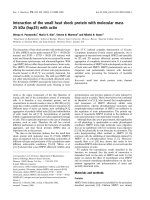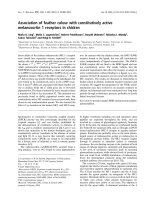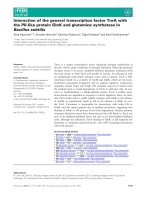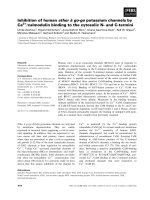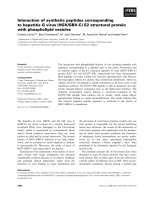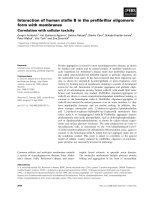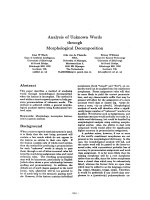báo cáo khoa học: " Interaction of silver nanoparticles with Tacaribe virus" pot
Bạn đang xem bản rút gọn của tài liệu. Xem và tải ngay bản đầy đủ của tài liệu tại đây (1.35 MB, 9 trang )
RESEARC H Open Access
Interaction of silver nanoparticles with Tacaribe
virus
Janice L Speshock, Richard C Murdock, Laura K Braydich-Stolle, Amanda M Schrand, Saber M Hussain
*
Abstract
Background: Silver nanoparticles possess many unique properties that make them attractive for use in biological
applications. Recently they received attention when it was shown that 10 nm silver nanoparticles were bactericidal,
which is promising in light of the growing number of antibiotic resistant bacteria. An area that has been largely
unexplored is the interaction of nanomaterials with viruses and the possible use of silver nanoparticles as an
antiviral agent.
Results: This research focuses on evaluating the interaction of silver nanoparticles with a New World arenavirus,
Tacaribe virus, to determine if they influence viral replication. Surprisingly exposing the virus to silver nanoparticles
prior to infection actually facilitated virus uptake into the host cells, but the silver-treated virus had a significant
reduction in viral RNA production and progeny virus release, which indicates that silver nanoparticles are capable
of inhi biting arenavirus in fection in vitro. The inhibition of viral replication must occur during early replication since
although pre-infection treatment with silver nanoparticles is very effective, the post-infection addition of silver
nanoparticles is only effective if administered within the first 2-4 hours of virus replication.
Conclusions: Silver nanoparticles are capable of inhibiting a prototype arenavirus at non-toxic concentrations and
effectively inhibit arenavirus replication when administered prior to viral infection or early after initial virus
exposure. This suggests that the mode of action of viral neutralization by silver nanoparticles occurs during the
early phases of viral replication.
Background
The family Arenaviridae is composed of 18 different
species of viruses divided into two antigenic group s, the
Old World and New World (Tac arib e comp lex) groups.
The Tacaribe complex, in addition to Tacaribe virus
(TCRV), includes the viral hemorrhagic fever-inducing
viruses Junin, Machupo, Guanarito, and Sabia. Close
antigenic relationships are observed between TCRV, a
non-human pathogen, and the category A arenaviruses
[1]. TCRV is a biochemically and serologically close
relative of Junin and Guanarito viruses but h as a low
pathogenic potential for humans and is more easily
amenable to laboratory study [2] . Arenaviruses are
highly fatal and currently have no available vaccines and
thereislittleresearchtosupport efficacy of antivirals
[3].
Current technology offers the possibility of generat-
ing new types of nanostructured materials (often 100
nm or smaller) with designed surface and structural
properties that render them reactive and able to bind
proteins avidly [4-6]. S ilver nanoparticles (Ag-NPs)
have received considerable attention for biological
applications and recently it was shown that highly con-
centrated and nonhazardous nanosized silver particles
canbeeasilypreparedinacost-effectivemannerand
possess antimicrobial properties [7]. The interaction of
NPswithmicroorganismsisanexpandingfieldof
research; however, little effort has been done to deter-
mine the interaction of metal NPs with viruses,
although recent studies have shown that replication of
HIV-1 [8] and Monkeypox virus [9] can be inhibited
by Ag-NPs.
This study focuses on understanding the interaction of
Ag-NPs with arenaviruses and the effects on v iral repli-
cation. Arenaviruses are enveloped viruses with an
ambisense RNA genome, which is structurally very
* Correspondence:
Applied Biotechnology Branch, Human Effectiveness Directorate, 711th
Human Performance Wing, U.S. Air Force Research Laboratory, 2729 R Street,
Wright-Patterson Air Force Base, OH, 45433-5707, USA
Speshock et al. Journal of Nanobiotechnology 2010, 8:19
/>© 2010 Speshock et al; licensee BioMed Central Ltd. This is an Open Access article distribu ted under the terms of th e Creative
Commons Attribution License ( which permits unrestricted use, distribution, and
reproduction in any medium, provided the original work is properly cited.
different than HIV or poxviruses [3]. The arenaviruses
also replicate differently than HIV or poxviruses, but
have a similar replication cycle to other important
viruses, such as filoviruses or orthomyxoviruses, both of
which are also enveloped, RNA viruses. Therefore it is
important to determine how Ag-NPs interact with
enveloped, RNA viruses to conclude if they are virucidal
against other virus families as well as HIV and
poxviruses. Two types of Ag-NPs are used in the subse-
quent study, uncoated (Ag-NP) and polysaccharide-
coated (PS-Ag), to assess the impact of biocompatible
coatings on viral replication since the addition of a poly-
saccharide coat onto Ag-NPs has been shown to
decrease their toxicity in mammalian cells [10]. Our
findings demonstrate that the interaction of TCRV with
Ag-NPs prior to cellular exposure results in a decrease
in viral infectivity with 10 and 25 nm Ag-NPs and the
addition of a polysaccharide coating on the Ag-NPs ren-
ders them slightly less effective at inhibiting viral
replication.
Results
Biocompatibility of Ag-NPs in Vero cells
Aft er a 24 hou r exposure, a 25% decline in cell viability
was observed in Vero cells exposed to 50 μg/ml of 1 0
nm uncoated Ag-NPs (Fig 1a). Treatments with 10 nm
uncoated Ag-NPs at 75 and 100 μg/ml resulted in a
60% reduction in cell viability (Fig 1a). There was no
further reduction in cell viability in the 50 μg/ml dose,
but the cells treated with 75-100 μg/ml died off by day
2 (Fig 1b, c). The 10 nm PS-Ag had no significant
effects on the Vero cells in the first 24 hours (Fig 1a)
but the 75 and 100 μg/ml doses demonstrated a 25%
reduction in viability after 48 hours (Fig 1b, c) suggest-
ing an instability of the coating. Doses lower than 50
μg/ml of either 10 nm NP had little effect on Vero cell
viability (Fig 1). There was little cytotoxicity observed in
Vero cells treated with either the uncoated or polysac-
charide-coated 25 nm Ag-NPs (Fig 1).
Ag-NP interactions with TCRV
Prior to determining the effect of Ag-NPs on TCRV
infection, we wanted to conclude whether or not there
are direct interactions between the Ag-NPs and the
virus. Table 1 represents a comparison of the Ag-NP
size distributions of the particles dried onto grids and
imaged using transmission electron microscopy (TEM;
Table 1a) and the size in solution determined by
dynamic light scattering (DLS; Table 1b-d). When added
to the cell culture media DMEM at 50 μg/ml, the Ag-
NPs aggregated to almost a micron in size with the 10
nm uncoated particles showing the greatest amount of
aggregation (Table 1b). Interestingly when the Ag-NPs
were incubated with TCRV at NP doses of 10 or 50 μg/
ml, a mean size of 300-500 or 400-900 nm, respectively,
was observed (Table 1c, d), which is smaller than the
aggregates formed by the Ag-NPs alone. As with the
aggregation of Ag-NPs in solution, the largest aggregates
formed with the virus are with the 10 nm un coated Ag-
NPs.TheAg-NP-TCRVaggregatesizeisbetweenthe
Ag-NP aggregates without virus and the size of the virus
(165 nm) in solution. This suggests that the Ag-NPs are
interacting with TCRV and that the binding affinity for
the viral proteins may be s tronger than that of the NPs
with each other.
TCRV neutralization by Ag-NPs
When incubated with the virus 1 hour prior to infection
of the Vero cells, the 10 nm uncoated Ag-NP resulted
in the most dramatic reduction in TCRV virus titer with
approximately 50% reduction in progeny virus titer at
10 μg/ml and no detectable progeny virus at 25 μg/ml
or greater (Fig 2). The PS-Ag (both 10 and 25 nm) also
had a significant reduction in virus titer at 10 and 25
μg/ml, and was almost und etectable at concentrations of
50 μg/ml and greater (Fig 2). However, the 25 nm PS-
Ag had 3 out of 6 replicates with detectable virus titers
at 50 μg/ml and 1 out of 6 trials at 100 μg/ml. The 25
nm uncoa ted Ag-NP did not significantly reduce TCRV
Figure 1 Biocompatibility of Ag-NPs in Vero cells. Vero cells were exposed to Ag-NPs for 24 hours (A), 48 hours (B), or 8 days (C) and the cell
viability was determined using a standard MTS assay. The effects of the Ag-NPs on cellular viability are expressed as percent of control
(untreated Vero cells) with error bars representing standard error of the mean (S.E.M.).
Speshock et al. Journal of Nanobiotechnology 2010, 8:19
/>Page 2 of 9
replication at concentrations lower than 25 μg/ml, but
there was no detectable virus titer at 50 or 100 μg/ml
with these particles (Fig 2).
Ag-NP treated TCRV interactions with the Vero cells
Fluorescently-tagged TCRV (green) was incubated with
Ag-NPs for 1 hour and then was used to infect Vero
cells for 4 hours. This time-point was chosen since it
was ample time for cellular interaction and internaliza-
tion of the virus, but the fluorescent tag diminished in
intensity for longer incubations. Following the incuba-
tion, c onfocal microscopy using serial sections through
the cell was used to image the cells with the figure
representing a collapsed z-stack of these sections. Vero
cells infected with untreated TCRV showed a good
amount of virus internalized and was well dispersed
throughout the monolayer (Fig 3b). TCRV treated with
either uncoated or PS-coated 10 nm Ag-NPs at 50 μg/
ml interacted with and internalized much more effi-
ciently into the cell than the untreated con trol (Fig 3c, e
versus 3b). The 10 μg/ml 10 nm treated viruses also
showed a sl ight increase in uptake into the cells but not
as dramatic and the 50 μg/ml dose (Fig 3d, f). The 25
nm PS-Ag 50 μg/ml treated TCRV had an increase in
internalization comparable to the 10 nm 10 μ g/ml treat-
ments (Fig 3i). The 10 μg/ml dose of the 25 nm PS-Ag
and either dose of the 25 nm uncoat ed Ag-NPs had
minimal effect on the cellular uptake of the virus (Fig
3g, h, j). Hoechst was used to label the nuc lei of the
cells.
Ag-NP treated TCRV internalization into Vero cells
While the z-sections through the confocal images sug-
gested internalization of TCRV into Vero cells even
when treated with Ag-NPs, we wanted to confirm that
the virus is indeed entering the cell using TEM. Fig 4a
and 4b depicts untreated TCRV inside of Vero cells.
The 10 nm Ag-NP (uncoated, 50 μg/ml) treated TCRV
is not only able to ente r the cel l but it also appears t o
have several virions enter into the same end osome (Fig
4c, d), which explains the large fluorescent aggregates
observed in the confocal images (Fig 3c, e). TCRV trea-
ted with 25 nm Ag-NPs (uncoated, 50 μg/ml) again is
effectively internalized into Vero cells (Fig 4e, f) but
they appear to enter individual endosomes (Fig 4f).
TEM micrographs were also added that show ed Ag-NPs
internalized into the same cell as a TCRV virion (Fig 4g,
h) and the Ag-NPs interacting with the virus outside of
the cell (Fig 4i, j).
Viral RNA replication
Since we determined that the virus is entering the cell
but progeny virus production is impa ired following pre-
treatment with Ag-NPs, we wanted to determine
whether the Ag-NPs inhibited viral RNA replication.
Therefore we examined the amount of S segment gene
expression in TCRV-infected Vero cells with and with-
out Ag-NP treatment. Arenaviruses have 2 strands of
RNA, the S and L segments. The S segment is the seg-
ment that encodes the nucleoprotein and GP1 and 2
proteins, which are early proteins and therefore are
detectable early in viral replication. At 25 and 50 μg/ml,
all 4 Ag-NPs tested had a dramatic reduction in t he
amount of S segment expression as compared to the
untreated TCRV control (Fig 5). This correlated with
Figure 2 TCRV repl ication following exposure to Ag-NPs. TCRV
was treated with uncoated and PS-coated 10 and 25 nm Ag-NPs
for 1 hour. Treated or control virus suspensions were used to infect
Vero cells for 8 days. Progeny virus was recovered from the cell
culture supernatant and was quantified using a standard tissue
culture infectious dose assay. Progeny virus titers are expressed as
the mean log
10
TCID
50
/mL +/- S.E.M. (T = concentration of
nanoparticles was toxic at this dose; *p < 0.05; student’s t test;
n = 6).
Table 1 Nanoparticle size distributions dry and in solution
10 nm 10 nm PS 25 nm 25 nm PS
(a) NP TEM size (SD) 10.20 (1.70) 9.48 (4.29) 27.47 (9.06) 25.98 (8.38)
(b) NPs in DMEM (PDI) 1440 (0.277) 658 (0.261) 830 (0.214) 986 (0.217)
(c) 10 μg NP + TCRV (PDI) 503 (0.334) 481 (0.444) 326 (0.366) 305 (0.344)
(d) 50 μg NP + TCRV (PDI) 974 (0.465) 756 (0.462) 524 (0.388) 426 (0.403)
The size distributions of the four Ag-NPs were determined using TEM size measurements with mean particle size and standard deviation (A), and DLS
measurements of Ag-NPs alone in DMEM (B), 10 μg of Ag-NPs incubated with TCRV for 1 hour (C), or 50 μg of Ag-NPs incubated with TCRV for 1 hour (D) with
average size and polydispersity index.
Speshock et al. Journal of Nanobiotechnology 2010, 8:19
/>Page 3 of 9
the significant reduction in progeny virus produced fol-
lowing the Ag-NP treatments. There was also a signifi-
cant decrease in the S segment gene expression of the
Vero cells infected with TCRV treated with 10 μg/ml of
10 and 25 nm uncoated Ag-NPs (Fig 5).
Post-infection Ag-NP treatment
Given that the replication of viral genes is inhibited in
Ag-NP-treated virus infections, we propose that t he Ag-
NPs must be acting on early stages of virus replication
to prevent infection.
Figure 4 TEMofTCRVinternalizationintoVerocells. TEM
micrographs depict Vero cells infected with untreated TCRV (a, b),
10 nm (uncoated, 50 μg/ml) treated TCRV (c, d), or 25 nm
(uncoated, 50 μg/ml) treated TCRV (e, f) with b, d, and f being
zoomed-in images of the white squares of a, b, and c. Images g
and h depict virus and the Ag-NPs localizing within the same cell,
and i and j depict the interaction of TCRV with the Ag-NPs outside
of the cell. White arrows are pointing towards the virus and black
arrows show the Ag-NPs.
Figure 3 Confocal imaging of untreated and Ag-NP-treated
TCRV in Vero cells. TCRV was labeled with a fluorophore that
excites at a wavelength of 488 nm and was treated with Ag-NPs for
1 hour. Treated or control virus was used to infect Vero cells for 4
hours. The supernatant was removed and the cells were washed 2
times with PBS to remove non-adherent virus and were fixed in 3%
paraformaldehyde. The nuclei were stained with Hoechst (blue) and
the images were taken using spinning disc Confocal microscopy
with the pictures representative of collapsed z-stacks of sections
through the cell (15 sections). (a) Vero cells alone (b) TCRV in Vero
cells (c) TCRV + 10 nm Ag 50 μg/ml (d) TCRV + 10 nm Ag 10 μg/ml
(e) TCRV + 10 nm PS-Ag 50 μg/ml (f) TCRV + 10 nm PS-Ag 10 μg/
ml (g) TCRV + 25 nm Ag 50 μg/ml (h) TCRV + 25 nm Ag 10 μg/ml
(i) TCRV + 25 nm PS-Ag 50 μg/ml (j) TCRV + 25 nm PS-Ag 10 μg/ml
(representative picture of 3 separate trials).
Speshock et al. Journal of Nanobiotechnology 2010, 8:19
/>Page 4 of 9
To conclude that the Ag-NPs are inhibiting early
steps of viral replication a nd to determine how effec-
tive the Ag-NPs would be as a therapeutic agent, we
administered the uncoated 10 nm Ag-NPs at a dose of
25 μg/ml at various time-points post-infection. This
dose with this NP was benign to the Vero cells, as
determined by a mitochondrial function assay (Fig 1),
and was completely effective at inhibiting viral replica-
tion when administered prior to infection (Fig 2). A
pre-treatment at -1 hour was used as a control for Ag-
NP inhibition and then the Ag-NPs were added to
virally-infected Vero cells at 0, 1, 2, 4, 8, and 24 hours
post-infection. At the -1, 0, and 1 hour time-points,
there was no detectable progeny virus produced (Fig
6). There was only one sample out of six trials that
had any detectable virus production when the Ag-NPs
were administered 2 hours post-infection (Fig 6). How-
ever, at 4 hours post-infection, only 50% of the trials
showed complete inhibition of viral replication, and
the 12 and 24 hours time-points had significantly
lower end virus titers than the untreated control, but
still had an elevated viral titer after the 8-day replica-
tion cycle (Fig 6). Alternatively, Vero cells were also
pre-treated with Ag-NPs for 1, 24, or 48 hours prior to
infection with TCRV. However, there was no detect-
able decline in virus titers or vRNA replication when
the Ag-NPs were administered to the cells pre-infec-
tion (data not shown).
Discussion
The goal for this study was to assess the interaction of
Ag-NPs with a prototypical arenavirus, TCRV, and to
determine if Ag-NPs could cause a significant decrease
in progeny virus production at a concentration that is
relatively benign to the host cell. Because of the capacity
for person-to-person aerosol transmission, the lack of
diagnostic testing, and limited therapeutic options, the
arenaviruses are included in the category A list of
potential bioweapons [11]. Although there is an experi-
mental vaccine for Junin, and ribavirin has shown some
efficacy, the vaccine is yet approved for human use and
viruses rapidly acquire resistance to antivirals, which
could leave people vulnerable to arenavirus diseases [3].
Since Ag-NPs have been suggested to be an alternative
anti-bacterial therapeutic, we wanted to determine if
they could also be used to prevent arenavirus infection.
Our findings s how that the uncoated 10 nm Ag-NPs
are toxic to Vero cells at dose s greater than 50 μg/ml
(Fig 1). However when TCRV was treated with 50 and
25 μ g/ml of these particles, i.e. nontoxic doses, there
was no detectable progeny virus produced (Fig 2). Even
at 10 μg/ml the 10 nm Ag-NP showed a significant
reduction in progeny virus titer, and the 10 nm PS-Ag
particles showed a similar trend but w ere not as effec-
tive (Fig 2). Significant toxicity of 10 nm PS-Ag was
only observed in the Vero cells at doses of 100 μg/ml,
but only 50 μg/ml was required for complete inhibition
of virus replication (Fig 2). Again the 1 0 and 25 μg/ml
Figure 5 S segment quantitative real time PCR analysis.TCRV
was treated with uncoated and PS-coated 10 and 25 nm Ag-NPs
for 1 hour. Treated or control virus was used to infect Vero cells for
4 days. The supernatant was removed and the cells were washed 2
times with PBS to remove non-adherent virus. RNA was isolated
from the Vero cells and S segment gene expression was
determined using qRT-PCR with Sybr green. Changes in S segment
gene expression are expressed as fold change over untreated TCRV
infection with error bars representing the S.E.M. and statistical
analysis comparing the untreated control to each of the treatment
groups. (*p < 0.05; student’s t test; n = 6).
Figure 6 Vero cells were infected with TCRV and were exposed
to 10 nm Ag-NPs at 25 μg/ml at 1, 2, 4, 8, and 24 hours post-
infection or the Ag-NPs were added concurrently with the
TCRV (0 hour). The -1 hour reflected the pre-exposure scenario of
figure 1 and was used as a control. The progeny virus produced
was harvested 8 days post-infection and is expressed as the mean
log
10
TCID
50
/mL. All treatments were significantly lower than the
“No NP” control as determined by the student’s t test with n = 6.
Speshock et al. Journal of Nanobiotechnology 2010, 8:19
/>Page 5 of 9
doses of the 10 nm PS-Ag caused a significant reduction
in viral replication, but it was not as effective as the
treatment with the uncoated 10 nm particles (Fig 2).
Therefore the polysaccharide coating may indeed pro-
tect the cell from the toxic effects of the Ag-NPs, but it
also appears to interfere with the Ag-NP interaction
with TCRV. The 25 nm particles, both PS-coated and
uncoated, displayed limited toxicity in the Vero cells
and they too inhibited viral replication at 50 μg/ml and
showed a significant reduction in progeny virus produc-
tion at 25 μg/ml. The inhibition by the 25 nm particles
suggests that arenavirus replication is inhibited by Ag-
NPs using a different mechanism than either HIV-1 or
Monkeypox virus, both of which are inhibited by 10 nm,
but not 25 nm Ag-NPs [8,9].
Previous research demonstrates that Ag-NPs preferen-
tially bind to the gp120 knob s of HIV virus [8]. Our
DLS data suggests that a similar trend may be occurring
with TCRV, and the Ag-N Ps are likely binding to the
membrane glycoproteins of the virus. Since there are
many cyst eines located throughout the TCRV glycopro-
teins [12] and Ag-NPs readily bind to the thiol groups
[13], which are found in cysteine residues, there is likely
a strong interaction between the TCRV and Ag-NPs.
This interaction will likely either prevent internalization
of the virus by inhibiting glycoprotein-receptor interac-
tions, or will internalize into the cell together and effect
viral replication within the cell. The later statement
appears to be the case since the confocal images depict
internalization of the virus and this is confirmed w ith
TEM. Ag-NPs have been shown to enter the cell via
macropinocytosis or clathrin-mediated endocytosis [14].
TCRV and other arenaviruses also enter the ce ll via cla-
thrin-mediated endocytosis via interaction with a cellu-
lar receptor [15]. The similarity of intracellular
internalization mechanisms further suggests the poten-
tial for intracellular inte ractions, illustrated by T EM
images that depict TCRV and Ag-NPs taken up into the
same cell, even if the glycoprotein-Ag-NP interaction is
not retained inside of the cell . Since the vRNA appea rs
to be inhibited i n Ag-NP-treated TCRV infections, this
could indicate that the Ag-NPs could be interfering with
the TCRV RNA-dependent RNA polymerase (L protein).
Ag and Ag-NPs have been shown to be capable of inhi-
biting enzyme activity [16,17] and perhaps the Ag-NPs
are inhibiting the enzymatic activity of the L protein
when T CRV and Ag- NPs enter in to the same cells.
However, the virus may not even able to get to the
RNA replication step. It is possible that the Ag-NPs
may be able to prevent the virus uncoating in the endo-
some. An alternative theory to explain the viral neutrali-
zation capabilities of Ag-NPs could be that they are
inferring with t he zinc (Zn)-finger motif of the virus. It
has been previously demonstrated that disulfide-based
compounds are capable of interacting with the cysteine
residues of the Zn-binding domains of Junin and TCRV,
which leads to cross-linking of the protein and loss of
the Zn [18]. Two arenavirus proteins, the nucleoprotein
and the small Z protein, have been shown to possess
Zn-binding motifs [19,20]. Garcia et al. concluded that
virions treated with disulfide-based compounds are cap-
able of entering the cell with the efficiency as untreated
virions, but they are not able to synthesize viral proteins
since they are inactivated by the compounds prior to
cell entry [18]. This is very similar to what we are obser-
ving with the Ag-NPs, which also readily bind to
cysteine residues. Since pre-treatment of the cells with
Ag-NPs had no effect on viral replication it is plausible
to assume that the Ag-NPs could be inactivating the
virus prior to entry into the cell.
Conclusion
TCRV is a prototype New World clad e B arenavirus that
shares structural and genomic homology with the South
American hemorrhagic fever viruses Junin, Machupo,
Guanarito, and Sabia [18]. Since these highly virulent
hemorrhagic viruses share the same proteins and mechan-
ism of replication as TCRV, the Ag-NPs will likely inhibit
their replication as well. Due to the known toxicity of Ag-
NPs in many human cell lines [10], and the short time
limit of efficacy following infection, the Ag-NPs would
likely make a more effective decontamination tool as
opposed to an in vivo therapeutic agent. However, if the
Ag-NPs do indeed facilitate the uptake of arenaviruses
into the cell and inactivate the virus prior to cell entry,
further studies should be performed to determine if Ag-
NPs can prove to be an effective vaccine adjuvant.
Materials and methods
Cell cultures and virus propagation
Vero cells (CCL-81; ATCC, Manassas, VA) were main-
tained in Dulbecco’s modified Eagle’s Medium (DMEM;
Biowhitaker, Basel, Switzerland) supplemented with 10%
heat-inactivate d fetal bo vine serum (FBS; Gibco, Carls-
bad, CA) and 1% Penicillin-Streptomycin (P/S; Invitro-
gen, Carlsbad, CA). Stocks of Tacaribe virus (TCRV;
VR-1556; ATCC, Manassas, VA) were prepared by
infecting the Vero cells at a low multiplicity of infection
(MOI = 0.01) for 1 hour at 37°C in 5% CO
2
. Following
virus absorp tion, unbound virus was removed and
washed with phosphate buffered saline (PBS), and
DMEM supplemented with 2% FBS and 1% PS was
added to the cells. The virus was allowed to replicate for
8 days at 37°C in 5% CO
2
, which is when complete cyto-
pathic effect was observed. Virus was recovered from
the cell supernatant and the cellular debris was removed
from the viral suspension via centrifugation at 580 × g
for 15 minutes (Allegra 25R Centrifuge; Beckman
Speshock et al. Journal of Nanobiotechnology 2010, 8:19
/>Page 6 of 9
Coulter, Fullerton, CA). The stocks were preserved with
1% bovine serum albumin (BSA;Sigma,St.Louis,MO)
and stored at -80°C.
Nanoparticles
Theuncoated25nmAg-NPswereakindgiftfromDr.
Karl Martin (Novacentrix, Austin, TX) and the uncoated
Ag-NPs at 10 nm were synthesized by Dr. Steven Old-
enburg (NanoComposix, San Diego, CA). Polysacchar-
ide-coat ed Ag-NPs (PS-Ag) 10 a nd 25 nm were a
generous gift from Dr. Dan Goia (Clarkson University,
Center for Advanced Materials Processing, Potsdam,
NY). These PS-Ag NPs were synthesized by the reduc-
tion of Ag ions i n solution by a p olysaccharide (acacia
gum), which leads to a polysaccharide surface coating
[10]. All Ag-NPs used in this study were spherical in
morphology and were diluted in deionized water to 1
mg/ml and were then further diluted in cell culture
media. Characterization data, such as TEM images and
size distribution, elemental analysis, and agglomera te
size in solution (DMEM using DLS) were supplied with
the NPs and confirmed in our laboratory [10].
Nanoparticle treatment
Ag-NPs were diluted in D MEM and sonicated w ith a
probe sonicator for dispersion. TCRV was added to the
Ag-NP/DMEM mixture at a 1:40 dilution (5 × 10
4
TCID
50
/mL) and the mixture was incubated at room
temperature with rotation for 1 hour. Following the
incubation the TCRV-NP mixture was added t o Vero
cell s, seeded to 90% conf luency, that were washed twice
with PBS. The viral suspension was allowed to absorb
for 1 hour at 37°C i n 5% CO
2
. Following absorption,
non-adherent virus was washed off using PBS, and
DMEM supplemented with 2% FBS and 1% P/S was
added to the cells which were then incubated at 37°C in
5% CO
2
for 8 days, which is the time at which cyto-
pathic effect was observed in nearly 100% of the cells
infected with the untreate d TCRV virus. Alternat ively,
samplesfromthe1hourincubationofAg-NPswith
TCRV were also analyzed for size changes and agglom-
erate formation using DLS.
Biocompatibility assay
Vero cells were seeded into 96-well tissue culture trea-
ted plates at a concentration of 50,000 cells/well.
Twenty-four hours post seeding, the Vero cells were
exposed to 10 or 25 nm Ag-NPs (either uncoated or PS-
coated). The NPs were diluted to the various doses in
DMEM+PS and sonicated with a probe sonicator for 30
seconds prior to exposure. At time points of 24 hours,
48 hours, and 8 days post exposure a standard MTS
assay ( Promega, Madison, WI) was performed to deter-
mine cell viability.
Viral Inhibition Assay
Vero cells were exposed to Ag-NP-treated TCRV as
described above. Following the 8-day incubation, pro-
geny virus was harvested from the supernatants of
infected cells and the cellular debris was removed from
the viral suspension via centrifugation at 580 × g for 15
minutes. Virus titers were determined from the superna-
tants using a tissue culture infectious dose assay [21].
Briefly, Vero cells were seeded into 48-well tissue cul-
ture treated plates and grown to 90% confluency. The
virus was serially diluted across six 10-fold dilutions and
100 μL aliquots per dilution (n = 8/dilution) were added
to the cells. The virus was allowed to absorb for 1 hour
at 37°C in 5% CO
2
. The cells were washed to remove
non-adherent virions and DMEM containing 2% FBS
and PS was added. The cells were incubated at 37°C in
5% CO
2
for 8 days. Progeny virus titers are expressed as
the reciprocal of the highest dilution that results in at
least 50% of the we lls displaying cytopathic effect [2 1].
Tissue culture infectious doses at 50% (TCID
50
)were
compared between NP-treated and untreated TCRV
infections.
Confocal microscopy
TCRV was tagged w ith a carboxylic ac id/succinimi dyl
ester mixed Alexaf luor that excites at a wavelength of
488 nm by adding 10 μL of the AlexaFluor to 600 μLof
concentrated virus in PBS and 400 μLof0.2Msodium
bicarbonate and incubate at room temperature with
rotation for 24 hours. The virus was recovered via cen-
trifugation at 30,000 × g for 1 hour in 100 mM Glycine.
TCRV~488 was incubated with Ag-NPs and then subse-
quently used to infect Vero cells for 4 hours, which was
sufficient for intrace llular detection but prior to dimin-
ishing of the fluorophore intensity. Hoechst was us ed
for a nuclear stain and the amount of cell bound and
internalized virus was examined using 15- 0.250 μmcell
section collapsed z-stack images obtained via confocal
microscopy (Becton Dickinson Pathway 435 spinning
disc confocal microscope; BD, Franklin Lakes, NJ).
Transmission Electron Microscopy
TCRV was incubated with the uncoated Ag-NPs at 50
μg/ml for 1 hour at room temperature with rotation.
The resulting suspension was then used to infect Vero
cells for 24 hours at 37°C in a 5% CO
2
atmosphere. Sev-
eral time-points were analyzed but the 24 hour seemed
to have a lot of detectable intracellular virions. The cells
were trypsinized, centrifuged at 500 × g, and fixed in a
2% paraformaldehyde/2.5% glutaraldehyde mixture for 2
hours. The cells were then washed and stained with 1%
osmium tetroxide (EM Sciences) for 1 hour. The cells
were washed again and stained with 2% phosphotungstic
acid for 5 minutes. Following the staining the cells were
Speshock et al. Journal of Nanobiotechnology 2010, 8:19
/>Page 7 of 9
dehydra ted with the addition of successively higher con-
centrations of EtOH. After the sample had been dehy-
drated with 100% EtOH, a 1:1 mixture of LR white
medium grade resin (EM Sciences) and 100% EtOH was
added to the samples for 1 hour. The mixture was
removed, and 100% resin was added. The resin was
cured overnight in a vacuum oven at 60°C, -15 inHg.
The embedded cells were thin sectioned on an ultrami-
crotome (Leica Ultracut) to ~50 nm and collected onto
carbon-formvar-coated C u TEM grids. Bright-field
transmission electron microscope (TEM, Hitachi S)
images were obtained for each sample at 100 kV.
S segment real time PCR
Vero cells were exposed to Ag-NP trea ted TCRV as
described above. Following 4-day incubation, the super-
natant was removed from the infected cells and the cells
were washed 2 times to remove non-internalized virus.
The 4-day time-point was chosen since the TCRV RNA
was easily detectable and produced in high amounts and
there was no evidence of cytopathic effect yet, which
could results in false-negative readings. RNA was pre-
pared from the cells using the Qiagen RNeasy kit with
the optional DNase treatment step. Concentrations of
the RNA were determined using the Nanodrop ND-
1000 spectrophotometer. Quantitative real time PCR
(qRT-PCR) was performed by adding 100 ng of each
RNA s ample in triplicate to a one-step Sybr green real
time PCR reaction mix (Invitrogen, Carlsbad, CA) and
was analyzed u sing the Stratagene Mx3005p real time
PCR machine (Stratagene, La Jolla, CA). The S gene seg-
ment was amplified using the following primers: F’
tgtgttggctggcagat, R’ aggagagtgaacaaagacat. b-actin w as
used for an i nternal control and was measured using
published primers [22].
Post-infection treatment with Ag-NPs
Vero cells were infecte d with untreated TCRV at 5 ×
10
4
TCID
50
/mLfor1hourat37°Cin5%CO
2
. Follow-
ing this incubation, the Vero cells were washed and
DMEM+2% FBS was added to the cells and the cells
were allowed to incubate for 8 days and progeny virus
titer was determined as stated above. Either concur-
rently with addition of the virus (0 hour) or the
DMEM/2% FBS (1 hour), or at various time-points
thereafter, 10 nm uncoated Ag-NPs were added to the
cells at 25 μg/ml. Changes in virus titer between the
untreated Vero cells and the Ag-NP-treated cells were
plotted.
Statistical analysis
Data were expressed as the mean ± standard error of
the mean (S.E.M.). The one-wa y ANOV A and the t-test
(MS Excel; Microsoft Corporation, Redmond, WA or
Prism 5 statistical and graphing software; GraphPad
Software,Inc,LaJolla,CA)wereusedforthedataana-
lysis. The one-way ANOVA was used to determine the
effect of test compound concentration on the mean
number of treatments/well. The two-sample t-test was
used to c ompare the average number of samples/well
between the untreated positive controls and each treat-
ment group. P ≤ 0.05 was used as the level for
significance.
Abbreviations
TCRV: Tacaribe virus; AG-NPS: silver nanoparticles; PS-AG: polysaccharide-
coated silver nanoparticles; TCID
50
: tissue culture infectious dose at 50%
infectivity.
Acknowledgements
We would like to thank the Defense Threat Reduction Agency (DTRA) for
funding and the JSTO-NRC postdoctoral fellowship program for funding Dr.
Janice Speshock and Dr. Amanda Schrand.
Authors’ contributions
JLS wrote the manuscript, completed Figs 1, 2, 5 and 6 entirely and set up
Figs 3, 4. RCM performed the TEM imaging and DLS experiment, and
characterized the Ag-NPs upon receipt. LKB-S performed the confocal
imaging. AMS wrote the TEM materials section. SMH is the laboratory
principle investigator and helped design the methods. All authors have read
and approved the manuscript.
Competing interests
The authors declare that they have no competing interests.
Received: 18 February 2010 Accepted: 18 August 2010
Published: 18 August 2010
References
1. Howard CR, Lewicki H, Allison L, Salter M, Buchmeier MJ: Properties and
Characterization of Monoclonal Antibodies to Tacaribe Virus. J Gen Virol
1985, 66:2344-2348.
2. Pedras-Vasconcelos JA, Goucher D, Puig M, Tonelli LH, Wang V, Ito S,
Verthelyi D: CpG Oligodeoxynucleotides Protect Newborn Mice from a
Lethal Challenge with the Neurotropic Tacaribe Arenavirus. J Immunol
2006, 176:4940-4949.
3. Charrel RN, Lamballerie : Areanviruses other than Lassa virus. Antivir Res
2003, 57:89-100.
4. Ashammakhi N: Nanosize, mega-impact, potential for medical
applications of nanotechnology. J Craniofac Surg 2006, 1:3-7.
5. Bender AR, von Briesen H, Kreuter J, Duncan IB, Rubsamen-Waigmann H:
Efficiency of nanoparticles as a carrier system for antiviral agents in
human immunodeficiency virus-infected human monocytes/
macrophages in vitro. Antimicrob Agents Chemother 1996, 40:1467-71.
6. Sondi I, Goia DV, Matijevi E: Preparation of highly concentrated stable
dispersions of uniform silver nanoparticles. J Colloid Interface Sci 2003,
260:75-81.
7. Sondi I, Salopek-Sondi B: Silver nanoparticles as antimicrobial agent: a
case study on E. coli as a model for Gram-negative bacteria. J Colloid
Interface Sci 2004, 275:177-82.
8. Elechiguerra JL, Burt JL, Morones JR, Camacho-Bragado A, Gao X, Lara HH,
Yacaman MJ: Interaction of silver nanoparticles with HIV-1. Jof
Nanobiotech 2005, 3:6.
9. Rogers JV, Parkinson CV, Choi YW, Speshock JL, Hussain SM: A Preliminary
Assessment of Silver Nanoparticle Inhibition of Monkeypox Virus Plaque
Formation. Nanoscale Res Lett 2008, 3:129-133.
10. Schrand AM, Braydich-Stolle LK, Schlager JJ, Dai L, Hussain SM: Can silver
nanoparticles be useful as potential biological labels? Nanotechnol 2008,
19:104-117.
Speshock et al. Journal of Nanobiotechnology 2010, 8:19
/>Page 8 of 9
11. Vela EM, Zhang L, Colpitts TM, Davey RA, Aronson JF: Arenavirus entry
occurs through a cholesterol-dependent, non-caveolar, clathrin-
mediated endocytic mechanism. Virology 2007, 369:1-11.
12. Iapalucci S, Lopez N, Franze-Fernandez MT: The 3’ end termini of the
Tacaribe arenavirus subgenomic RNAs. Virology 1991, 182:269-278.
13. Kim J, Kwon S, Ostler E: Antimicrobial effect of silver-impregnated
cellulose: potential for antimicrobial therapy. JBiolEng2009, 3:20.
14. Asharani PV, Prakash-Hande M, Valiyaveettil S: Anit-proliferative activity of
silver nanoparticles. BMC Cell Biol 2009, 10:65.
15. Guadalupe Martinez M, Cordo SM, Candurra NA: Characterization of Junín
arenavirus cell entry. J Gen Virol 2007, 88:1776-1784.
16. Hussain S, Meneghini E, Moosmayer M, Lacotte D, Anner BM: Potent and
reversible interaction of silver with pure Na, K ATPase and Na, K ATPase
liposomes. Biochem Biophys Acta 1994, 1190:402-408.
17. Braydich-Stolle LK, Lucas B, Schrand A, Murdock RC, Lee T, Schlager J,
Hussain S, Hofmann M-C: Silver nanoparticles disrupt GDNF signaling in
spermatogonial stem cells independent of nanoparticle sizing and
coating. Tox Sci .
18. Garcia CC, Candurra NA, Damonte EB: Mode of inactivation of
arenaviruses by disulfide-based compounds. Antivir Res 2002, 55:437-446.
19. Tortorici MA, Ghiringhelli PD, Lozano ME, Albarino CG, Romanowski V: Zinc-
binding properties of Junin virus nucleocapsid protein. J Gen Virol 2001,
82:121-128.
20. Salvato MS, Shimomaye EM: The completed sequence of lymphocytic
choriomeningitis virus reveals a unique RNA structure and a gene for a
zinc finger protein. Virology 1989, 173:1-10.
21. Reed LJ, Muench H: A Simple method of estimating fifty percent end
points. Am J Hyg 1938, 27:493-497.
22. Huang HY, Wen Y, Valbuena D, Krussel JS, Polan ML: Interleukin-1
regulates Vero Cell interleukin-1 receptor type I messenger ribonucleic
acid expression. Biol Reprod 1997, 57:783-790.
doi:10.1186/1477-3155-8-19
Cite this article as: Speshock et al .: Interaction of silver nanoparticles
with Tacaribe virus. Journal of Nanobiotechnology 2010 8:19.
Submit your next manuscript to BioMed Central
and take full advantage of:
• Convenient online submission
• Thorough peer review
• No space constraints or color figure charges
• Immediate publication on acceptance
• Inclusion in PubMed, CAS, Scopus and Google Scholar
• Research which is freely available for redistribution
Submit your manuscript at
www.biomedcentral.com/submit
Speshock et al. Journal of Nanobiotechnology 2010, 8:19
/>Page 9 of 9

